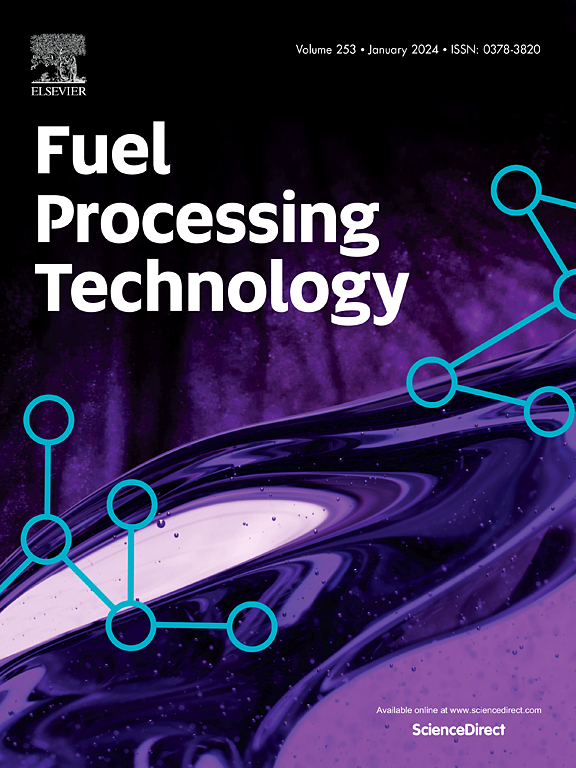耦合Fenton氧化和光催化预处理:减少生物质中aems以提高煤共燃性能的新策略
IF 7.2
2区 工程技术
Q1 CHEMISTRY, APPLIED
引用次数: 0
摘要
生物质燃料中碱和碱土金属(AAEMs)的高含量加剧了与煤共燃时的结渣和腐蚀,从而限制了工业利用。为了解决这些挑战,本研究提出了一种结合Fenton和光催化工艺的绿色预处理方法。以负载g- c3n4的海藻酸钙微球处理核桃壳,同时进行模拟日光照射和Fenton氧化。采用热重分析方法研究了煤掺加预处理和未处理的煤质的燃烧特性。结果表明,当升温速率为20°C/min时,燃烧性能指数(S)提高了170%。x射线荧光(XRF)分析表明,预处理使粉煤灰中AAEMs的含量降低了53.5%,其中K₂O和Na₂O的浓度从5.21%降低到0.87%。结渣指数分析进一步证实了降低的结渣风险,结渣指数为0.158,结垢指数为0.129。使用无模型方法进行的动力学分析表明,与未经处理的核桃壳-煤混合物相比,预处理的核桃壳-煤混合物的活化能增加了12.8% (E = 149.94 kJ/mol),表明AAEMs对煤降解的催化作用受到抑制。这项工作建立了优化生物质-煤共燃系统的可持续战略,提高了环境兼容性和工业适用性。本文章由计算机程序翻译,如有差异,请以英文原文为准。
Coupled Fenton oxidation and photocatalytic pretreatment: A novel strategy for reducing AAEMs in biomass to enhance coal co-combustion performance
The high content of alkali and alkaline earth metals (AAEMs) in biomass fuels exacerbates slagging and corrosion during co-combustion with coal, thereby limiting industrial utilization. To address these challenges, this study proposes a green pretreatment combining Fenton and photocatalytic processes. Walnut shells (WS) were treated with g-C3N4-loaded calcium alginate microbeads under simultaneous simulated daylight irradiation and Fenton oxidation. Thermogravimetric analysis was employed to investigate the combustion characteristics of coal blended with pretreated and untreated WS. Results demonstrated a 170 % enhancement in the combustion performance index (S) at a heating rate of 20 °C/min. X-ray fluorescence (XRF) analysis revealed that the pretreatment reduced AAEMs content by 53.5 %, specifically decreasing K₂O and Na₂O concentrations in ash from 5.21 % to 0.87 %. Slagging indices analysis further confirmed mitigated fouling risks, showing a low slagging index of 0.158 and a fouling index of 0.129. Kinetic analysis using model-free methods indicated a 12.8 % increase in activation energy (E = 149.94 kJ/mol for pretreated walnut shells-coal blends compared to 132.91 kJ/mol for untreated blends), indicating a suppression of the catalytic effects of AAEMs on coal degradation. This work establishes a sustainable strategy for optimizing biomass-coal co-combustion systems with improved environmental compatibility and industrial applicability.
求助全文
通过发布文献求助,成功后即可免费获取论文全文。
去求助
来源期刊

Fuel Processing Technology
工程技术-工程:化工
CiteScore
13.20
自引率
9.30%
发文量
398
审稿时长
26 days
期刊介绍:
Fuel Processing Technology (FPT) deals with the scientific and technological aspects of converting fossil and renewable resources to clean fuels, value-added chemicals, fuel-related advanced carbon materials and by-products. In addition to the traditional non-nuclear fossil fuels, biomass and wastes, papers on the integration of renewables such as solar and wind energy and energy storage into the fuel processing processes, as well as papers on the production and conversion of non-carbon-containing fuels such as hydrogen and ammonia, are also welcome. While chemical conversion is emphasized, papers on advanced physical conversion processes are also considered for publication in FPT. Papers on the fundamental aspects of fuel structure and properties will also be considered.
 求助内容:
求助内容: 应助结果提醒方式:
应助结果提醒方式:


